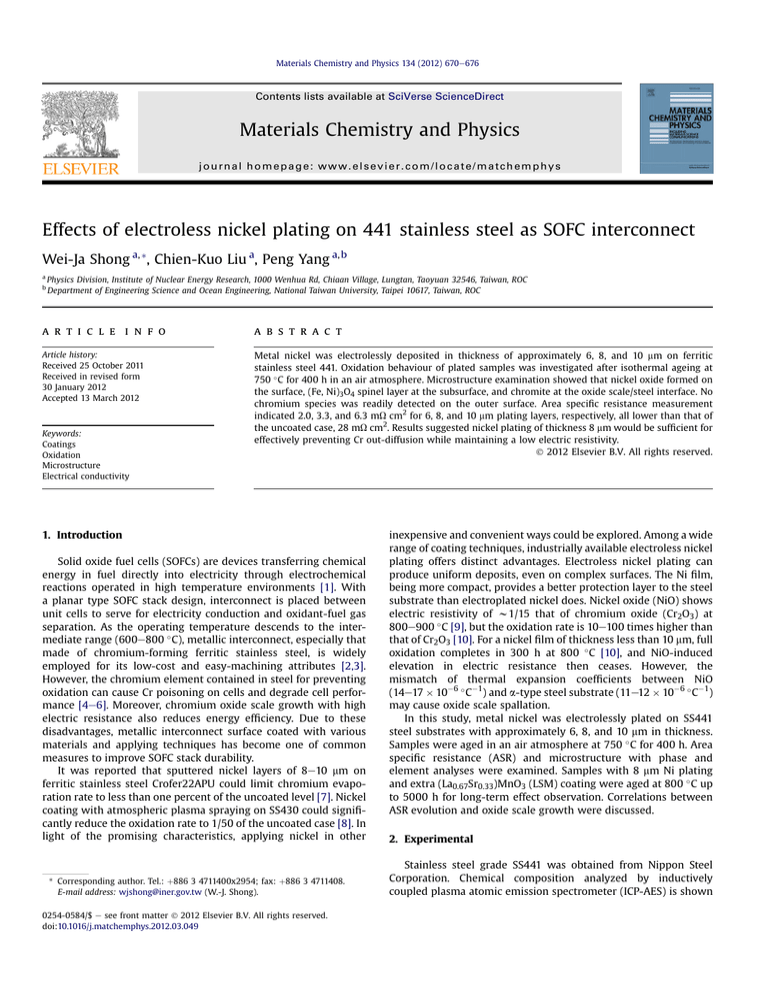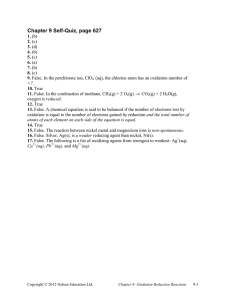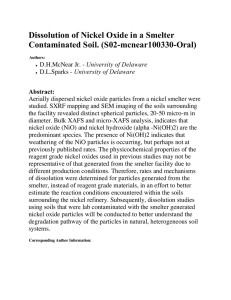
Materials Chemistry and Physics 134 (2012) 670e676
Contents lists available at SciVerse ScienceDirect
Materials Chemistry and Physics
journal homepage: www.elsevier.com/locate/matchemphys
Effects of electroless nickel plating on 441 stainless steel as SOFC interconnect
Wei-Ja Shong a, *, Chien-Kuo Liu a, Peng Yang a, b
a
b
Physics Division, Institute of Nuclear Energy Research, 1000 Wenhua Rd, Chiaan Village, Lungtan, Taoyuan 32546, Taiwan, ROC
Department of Engineering Science and Ocean Engineering, National Taiwan University, Taipei 10617, Taiwan, ROC
a r t i c l e i n f o
a b s t r a c t
Article history:
Received 25 October 2011
Received in revised form
30 January 2012
Accepted 13 March 2012
Metal nickel was electrolessly deposited in thickness of approximately 6, 8, and 10 mm on ferritic
stainless steel 441. Oxidation behaviour of plated samples was investigated after isothermal ageing at
750 C for 400 h in an air atmosphere. Microstructure examination showed that nickel oxide formed on
the surface, (Fe, Ni)3O4 spinel layer at the subsurface, and chromite at the oxide scale/steel interface. No
chromium species was readily detected on the outer surface. Area specific resistance measurement
indicated 2.0, 3.3, and 6.3 mU cm2 for 6, 8, and 10 mm plating layers, respectively, all lower than that of
the uncoated case, 28 mU cm2. Results suggested nickel plating of thickness 8 mm would be sufficient for
effectively preventing Cr out-diffusion while maintaining a low electric resistivity.
Ó 2012 Elsevier B.V. All rights reserved.
Keywords:
Coatings
Oxidation
Microstructure
Electrical conductivity
1. Introduction
Solid oxide fuel cells (SOFCs) are devices transferring chemical
energy in fuel directly into electricity through electrochemical
reactions operated in high temperature environments [1]. With
a planar type SOFC stack design, interconnect is placed between
unit cells to serve for electricity conduction and oxidant-fuel gas
separation. As the operating temperature descends to the intermediate range (600e800 C), metallic interconnect, especially that
made of chromium-forming ferritic stainless steel, is widely
employed for its low-cost and easy-machining attributes [2,3].
However, the chromium element contained in steel for preventing
oxidation can cause Cr poisoning on cells and degrade cell performance [4e6]. Moreover, chromium oxide scale growth with high
electric resistance also reduces energy efficiency. Due to these
disadvantages, metallic interconnect surface coated with various
materials and applying techniques has become one of common
measures to improve SOFC stack durability.
It was reported that sputtered nickel layers of 8e10 mm on
ferritic stainless steel Crofer22APU could limit chromium evaporation rate to less than one percent of the uncoated level [7]. Nickel
coating with atmospheric plasma spraying on SS430 could significantly reduce the oxidation rate to 1/50 of the uncoated case [8]. In
light of the promising characteristics, applying nickel in other
* Corresponding author. Tel.: þ886 3 4711400x2954; fax: þ886 3 4711408.
E-mail address: wjshong@iner.gov.tw (W.-J. Shong).
0254-0584/$ e see front matter Ó 2012 Elsevier B.V. All rights reserved.
doi:10.1016/j.matchemphys.2012.03.049
inexpensive and convenient ways could be explored. Among a wide
range of coating techniques, industrially available electroless nickel
plating offers distinct advantages. Electroless nickel plating can
produce uniform deposits, even on complex surfaces. The Ni film,
being more compact, provides a better protection layer to the steel
substrate than electroplated nickel does. Nickel oxide (NiO) shows
electric resistivity of w1/15 that of chromium oxide (Cr2O3) at
800e900 C [9], but the oxidation rate is 10e100 times higher than
that of Cr2O3 [10]. For a nickel film of thickness less than 10 mm, full
oxidation completes in 300 h at 800 C [10], and NiO-induced
elevation in electric resistance then ceases. However, the
mismatch of thermal expansion coefficients between NiO
(14e17 106 C1) and a-type steel substrate (11e12 106 C1)
may cause oxide scale spallation.
In this study, metal nickel was electrolessly plated on SS441
steel substrates with approximately 6, 8, and 10 mm in thickness.
Samples were aged in an air atmosphere at 750 C for 400 h. Area
specific resistance (ASR) and microstructure with phase and
element analyses were examined. Samples with 8 mm Ni plating
and extra (La0.67Sr0.33)MnO3 (LSM) coating were aged at 800 C up
to 5000 h for long-term effect observation. Correlations between
ASR evolution and oxide scale growth were discussed.
2. Experimental
Stainless steel grade SS441 was obtained from Nippon Steel
Corporation. Chemical composition analyzed by inductively
coupled plasma atomic emission spectrometer (ICP-AES) is shown
W.-J. Shong et al. / Materials Chemistry and Physics 134 (2012) 670e676
Table 1
Chemical composition for selected elements of as-received SS441 (wt%).a
Mn
Cr
Nb
Ti
Al
Ni
0.26
17.30
0.36
0.11
0.005
0.11
a
Analyzed with inductively coupled plasma atomic emission spectrometer.
in Table 1. A steel sheet of 2.5 mm thick was cut into 1 1 cm2
specimens and abraded with #1200 grit emery paper. Prior to
electroless nickel plating, specimen surfaces were degreased and
activated. The activation step was to slightly etch and roughen the
surface for better deposit attachment. Each step was followed by
water rinsing to remove chemicals. The specimens were then
immersed in a proprietary solution. Plating thickness grew at an
estimated rate of 4 mm/15 min to reach around 6, 8, and 10 mm in
thickness. Finished objects were water rinsed and completely dried.
671
Ni-plated and uncoated samples were aged together in a furnace
at 750 C for up to 400 h. Within the furnace space, a stagnant air
atmosphere was present without particular humidity control. ASR
values were monitored using a multichannel four-wire probing
system over the ageing period. The microstructures were examined
using a scanning electron microscope (SEM, Hitachi S-4800, Tokyo,
Japan), equipped with an energy dispersive X-ray spectroscopy
(EDS) to determine the elemental compositions. The crystalline
phases and structures of the oxide layer were analyzed by a Bruker
D8 Discover X-ray diffractometer (XRD) (Karlsruhe, Germany)
equipped with Cu-Ka radiation. The operation current and voltage
were 40 mA and 40 kV, respectively. The scanning range was
2q ¼ 15 e85 and scanning speed 4 min1.
Another long-term ageing process was conducted to examine
the effect of 8 mm Ni films at 800 C for 5000 h. An additional LSM
Fig. 1. SEM cross-sectional views and EDS line scans of original electrolessly nickel plated SS441 with thickness of (a) 6 mm; (b) 8 mm; (c) 10 mm.
672
W.-J. Shong et al. / Materials Chemistry and Physics 134 (2012) 670e676
Fig. 2. Surface morphology of SS441 after ageing at 750 C in an air atmosphere for 200 h: (a) uncoated; (b) 6 mm; (c) 8 mm; (d) 10 mm Ni coating.
coating layer was applied on top of the 8 mm Ni film for further
oxidation and Cr out-diffusion prevention [11]. The amorphous
LSM coating layer was deposited using a pulsed DC magnetron
sputter coater at 1.5 kW of power [12]. Sputter coating was performed in an argon atmosphere at a pressure of 7.5 mTorr and
a flow rate of 130 sccm. The thickness of the LSM layer was
approximately 4 mm. A Ni/LSM double-layered specimen and an
LSM single-layered reference specimen were aged together at
800 C. A constant air flow from the ambient environment was
introduced into the furnace at a rate of 2 l min1. The humidity of
the ambient air was w3%. No specific humidity control was taken
on the air flow. ASR values were measured using the same fourwire probing system during the ageing process.
3. Results and discussion
Fig. 1 shows SEM cross-sectional images corresponding to the
original electrolessly nickel plated SS441 with thicknesses of 6, 8,
and 10 mm, respectively. Metal nickel was deposited with uniform
thickness and well adhered to the steel substrate. The EDS scan
lines show abrupt changes of element concentration distributions
at the interface. This suggests that no inter-diffusion occurred
between the Ni layer and the steel substrate. An XRD analysis on
the surface of the 8 mm Ni as-plated sample revealed that the nickel
layer was amorphous (see Fig. 3).
After being aged at 750 C for 200 h, the uncoated sample
showed pyramid-shaped grains on the surface (Fig. 2). In contrast,
Fig. 3. XRD patterns for SS441 uncoated, and with 6 mm, 8 mm, and 10 mm Ni coatings. (After ageing at 750 C in an air atmosphere for 200 h).
W.-J. Shong et al. / Materials Chemistry and Physics 134 (2012) 670e676
673
Fig. 4. Surface morphology of SS441 after ageing at 750 C in an air atmosphere for 400 h: (a) uncoated; (b) 6 mm; (c) 8 mm; (d) 10 mm Ni coating.
the Ni-plated surfaces exhibited a denser crystalline structure. XRD
analyses indicated (Mn, Cr)3O4 spinel crystallites on the uncoated
sample, and NiO and (Ni, Fe)3O4 spinel for the Ni-plated ones
(Fig. 3). The thermally grown nickel oxides were all of similar sizes
at this stage.
Surface morphologies of the 750 C, 400-h aged samples are
shown in Fig. 4. For the uncoated sample, pyramid-shaped crystallites were not apparently observed. Instead, irregularly-shaped
grains and a more homogeneous spinel layer below were present.
Ni-plated surfaces exhibited crystalline structures. The crystal size
varied with the Ni plating thickness, thicker plating yielding larger
grains. XRD analyses (Fig. 5) revealed similar results as in the 200-h
ageing period. (Mn, Cr)3O4 spinel appeared on the uncoated sample
while NiO and (Ni, Fe)3O4 spinel formed on the Ni-plated surfaces.
Cross sectional views are shown in Fig. 6. Sample areas under the
silver electrodes used for ASR measurement were specifically
examined [13]. The scale formed on the uncoated surface was
mainly composed of chromium oxide. It was observed that Cr
diffused farther into the attached Ag electrode region. The chromium content in the Ag electrode was higher than in the bulk steel
zone next to the oxide scale/steel interface. In a testing environment at 750 C, the phase of silver chromite (AgCrO2) could form
and contribute to electric resistance [14]. At SOFC operating
temperatures above 625 C, silver chromium oxide evaporates and
contaminates the cathode of cells [15]. For nickel plated samples,
the oxide scale thickness was proportional to the original plating
Fig. 5. XRD patterns for SS441 uncoated, and with 6 mm, 8 mm, and 10 mm Ni coatings. (after ageing at 750 C in an air atmosphere for 400 h).
674
W.-J. Shong et al. / Materials Chemistry and Physics 134 (2012) 670e676
thickness. Nickel oxide formed at the outer surface, followed by
a NieFe spinel layer. Chromium oxide remained in the back of the
scale structure at the oxide scale/steel interface. The EDS scan line
indicated that Cr species was blocked and did not diffuse to the
surface. It is noticed that Ni diffused into the bulk steel substrate
significantly, at a level compatible with or higher than the Cr
concentration in the sub-interface zone. The rich nickel content
was likely to induce the formation of austenite. The effect of this
new phase requires further investigation. The concentration
distributions of chromium and nickel elements reveal exclusive
trends in the steel substrate. Ni species seemed to exert an expelling effect on Cr species. This is attributed to the excellent FeeNi
inter-solubility, which can enhance the oxide scale adherence.
Despite the existence of microcavities at the oxide scale/steel
interface, scale spallation was not observed on the Ni-plated
surface. Neither was spallation found on uncoated SS441 samples,
not as occurred on SS430 [16,17]. The concern for scale spallation
needs to be clarified in more realistic SOFC operation environments. Testing conditions may include thermal cycling, humidified
oxidant and dual (reducing and oxidizing) atmospheres.
The ASR evolution of the Ni-plated samples is shown in Fig. 7 for
the 400-h isothermal ageing at 750 C in an air atmosphere. The
ASR value escalated with plating thickness, but not in linear
proportion to the oxide scale thickness measured in Fig. 6. This is
due to the complex oxide scale structure which comprises chromite, NieFe spinel and nickel oxide with various intrinsic resistance. All samples exhibited no significant ASR variation over the
ageing period. The 6 mm Ni-plated specimen showed a mild rising
slope of w16% over the 200e400 h ageing interval. This was
probably due to the steady growth of chromium oxide. The 8 mm
Fig. 6. SEM cross-sectional views and EDS line scans of SS441 after ageing at 750 C in an air atmosphere for 400 h: (a) uncoated; (b) 6 mm; (c) 8 mm; (d) 10 mm Ni coating.
W.-J. Shong et al. / Materials Chemistry and Physics 134 (2012) 670e676
Fig. 7. The ASR evolution with ageing time at 750 C in an air atmosphere for SS441
electrolessly plated with 6 mm, 8 mm, and 10 mm Ni layers. (Data were not recorded
between 50 and 100 h)
and 10 mm Ni-plated specimens displayed slight decrease (1.2%)
and increase (þ3.1%) trends respectively in the last 200-h ageing
course. The nearly flat ASR trends of the 8 and 10 mm Ni-plated
specimens suggest that nickel oxide of sufficient thickness can
effectively retard chromia growth. From Fig. 6, both 8 and 10 mm Niplated specimens contained thinner chromium oxide layers than
the 6 mm one did. The increasing trend of the 10 mm Ni-plated
specimen is mainly attributed to the gradual growth of (Ni,
Fe)3O4 layer. The resistivity of (Ni, Fe)3O4 is approximately two
675
orders of magnitude less than that of Cr2O3 at 800 C [18]. The
development of the relatively low-resistant (Ni, Fe)3O4 layer with
an impaired Cr2O3 growth rate resulted in the small positive slope
of the ASR trend for the 10 mm Ni-plated specimen. The descending
ASR behaviour of the 8 mm Ni-plated sample is supposedly due to
the continuous inward diffusion of nickel element from the initially
grown nickel oxide scale. Comparing the EDS scan lines of Fe and Ni
elements for the 8 and 10 mm Ni-plated cross sections in Fig. 6
reveals some differences. According to the Fe distribution in the
8 mm case, it is suspected that the (Ni, Fe)3O4 phase, though
detected from the XRD analyses (see Fig. 5), did not develop as well
as in the 10 mm case. Thus the resistance contribution from (Ni,
Fe)3O4 for the 8 mm Ni-plated sample still remained minor before
400 h.
At the end of the 400-h ageing period, ASR values reached 2.0,
3.3 and 6.3 mU cm2 for the 6, 8, and 10 mm Ni-plated specimens,
respectively. As a comparison, the ASR of the uncoated SS441
sample rose up to 28 mU cm2, mostly due to the formation of highly
resistant chromium oxide scale.
For the three nickel plating thicknesses, the 6 mm Ni film could
block chromium out-diffusion and showed the lowest ASR value
after the 400-h ageing. However, the increasing ASR trend suggested chromium oxide was still growing at a moderate rate. A
thicker nickel film (8 or 10 mm) could yield an enhanced chromia
suppression ability, but with a more elevated ASR level. To prevent
chromium out-diffusion and oxide growth while maintaining good
electric conductivity, 8 mm appears to be an adequate nickel plating
thickness.
The 5000-h 800 C ageing results of the 8 mm Ni/LSM doublelayered sample and the LSM single-layered reference sample are
shown in Fig. 8. The ASR of the Ni/LSM coated sample started with
a higher initial level due to the thicker coating. The resistance
evolved with a slower rising trend and turned lower than that of
the LSM coated sample after w1000 h of ageing. No spallation was
found on the Ni/LSM coated surface. The results suggest a promising application of electroless nickel plating.
4. Conclusions
1. Nickel layers of 6, 8, and 10 mm in thickness have been electrolessly plated on stainless steel SS441. The Ni-plated and
uncoated samples were aged at 750 C for 400 h in an air
atmosphere. After the ageing process, ASR values were
measured 2.0, 3.3, and 6.3 mU cm2 for the 6, 8, and 10 mm Niplated samples respectively, and 28 mU cm2 for the uncoated
sample.
2. FeeNi inter-diffusion between the steel substrate and the Ni
plating layer can enforce adhesion of surface oxide scale.
3. Ni plating thickness of 8 mm or more, due to formation of
sufficiently thick nickel oxide scale on the surface and a FeeNi
spinel layer at the subsurface, can effectively prevent Cr outdiffusion from the bulk steel.
4. For the 6, 8, and 10 mm Ni plating thicknesses, 8 mm thickness is
considered adequate to meet both the Cr-preventing and ASRminimizing requirements.
References
Fig. 8. The ASR evolution with ageing time at 800 C in an air atmosphere for SS441
with both Ni/LSM and LSM coatings.
[1] N.Q. Minh, J. Am, Ceram. Soc. 76 (3) (1993) 563.
[2] J.W. Fergus, Mater. Sci. Eng. A397 (2005) 271.
[3] W.J. Quadakkers, J. Piron-Abellan, V. Shemet, L. Singheiser, Mater. High Temp.
20 (2003) 115.
[4] K. Hilpert, D. Das, M. Miller, D.H. Peck, R. Weib, J. Electrochem. Soc. 143 (1996)
3642.
[5] S.P.S. Badwal, R. Deller, K. Foger, Y. Ramprakash, J.P. Zhang, Solid State Ionics
99 (1997) 297.
[6] J.W. Fergus, Int. J. Hydrogen Energ. 32 (2007) 3664.
676
W.-J. Shong et al. / Materials Chemistry and Physics 134 (2012) 670e676
[7] M. Stanislowski, J. Froitzheim, L. Niewolak, W.J. Quadakkers, K. Hilpert,
T. Markus, L. Singheiser, J. Power Sources 164 (2007) 578.
[8] C. Fu, K. . Sun, X. Chen, N. Zhang, D. Zhou, Corros. Sci. 50 (2008) 1926.
[9] W.Z. Zhu, S.C. Deevi, Mater. Sci. Eng. A 348 (2003) 227.
[10] R.W. Jackson, J.P. Leonard, F.S. Pettit, G.H. Meier, Solid State Ionics 179 (2008) 2111.
[11] Y. Yoo, M. Dauga, in: Proc. 7th Int. Symp. SOFC-VII, Ibaraki, Japan, June 3e8,
2001, Electrochemical Society, Pennington, 2001, p. 837.
[12] D.-J. Jan, C.-T. Lin, C.-F. Ai, Thin Solid Films 516 (2008) 6300.
[13] W.-J. Shong, C.-K. Liu, C.-Y. Chen, C.-C. Peng, H.-J. Tu, G.T.-K. Fey, R.-Y. Lee,
H.-M. Kao, Mater. Chem. Phys. 127 (2011) 45.
[14] S.W. Sofie, P. Gannon, V. Gorokhovsky, J. Power Sources 191 (2009) 465.
[15] H.W. Abernathy, E. Koep, C. Compson, Z. Cheng, M. Liu, J. Phys. Chem. C 112
(2008) 13299.
[16] N. Shaigan, D.G. Ivey, W. Chen, J. Electrochem, Soc 155 (2008) D278.
[17] S. Geng, Y. Li, Z. Ma, L. Wang, L. Li, F. Wang, J. Power Sources 195 (2010) 3256.
[18] J.H. Zhu, S.J. Geng, Z.G. Lu, W.D. Porter, J. Electrochem. Soc. 154 (2007) B1288.





